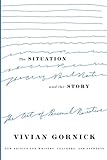The situation and the story : the art of personal narrative / Vivian Gornick.
Material type: TextLanguage: Spanish Publication details: New York : Farrar, Straus, and Giroux, 2002.Edition: New ed. for writers, teachers, and students, 1st pbk. edDescription: 174 p. ; 20 cmISBN:
TextLanguage: Spanish Publication details: New York : Farrar, Straus, and Giroux, 2002.Edition: New ed. for writers, teachers, and students, 1st pbk. edDescription: 174 p. ; 20 cmISBN: - 0374528586 (pbk. : alk. paper)
- 820.9/492 21
- PR 756 G671s 2002
| Item type | Current library | Home library | Collection | Shelving location | Call number | Copy number | Status | Date due | Barcode |
|---|---|---|---|---|---|---|---|---|---|
 Libro
Libro
|
Biblioteca Juan Bosch | Biblioteca Juan Bosch | Humanidades | Humanidades (4to. Piso) | PR 756 G671s 2002 (Browse shelf(Opens below)) | 1 | Available | 00000124308 |
Browsing Biblioteca Juan Bosch shelves, Shelving location: Humanidades (4to. Piso), Collection: Humanidades Close shelf browser (Hides shelf browser)

|

|

|

|

|

|

|
||
| PR 595 L529o 2007 On form : poetry, aestheticism, and the legacy of a word / | PR 651 H121s 2013 A short history of English Renaissance drama / | PR 756 C178 2002 The Cambridge companion to travel writing / | PR 756 G671s 2002 The situation and the story : the art of personal narrative / | PR 756 T779 2009 Travel writing, form, and empire : the poetics and politics of mobility / | PR 756 Y81c 2013 The Cambridge introduction to travel writing / | PR 821 E11n 2009 La novela inglesa : una introducción / |
Includes bibliographical references (p. 173-174).
A guide to the art of personal writing, by the author of Fierce Attachments and The End of the Novel of Love All narrative writing must pull from the raw material of life a tale that will shape experience, transform event, deliver a bit of wisdom. In a story or a novel the I who tells this tale can be, and often is, an unreliable narrator but in nonfiction the reader must always be persuaded that the narrator is speaking truth.How does one pull from one's own boring, agitated self the truth-speaker who will tell the story a personal narrative needs to tell? That is the question The Situation and the Story asks--and answers. Taking us on a reading tour of some of the best memoirs and essays of the past hundred years, Gornick traces the changing idea of self that has dominated the century, and demonstrates the enduring truth-speaker to be found in the work of writers as diverse as Edmund Gosse, Joan Didion, Oscar Wilde, James Baldwin, or Marguerite Duras.This book, which grew out of fifteen years teaching in MFA programs, is itself a model of the lucid inteligence that has made Gornick one of our most admired writers of ninfiction. In it, she teaches us to write by teaching us how to read: how to recognize truth when we hear it in the writing of others and in our own.


There are no comments on this title.